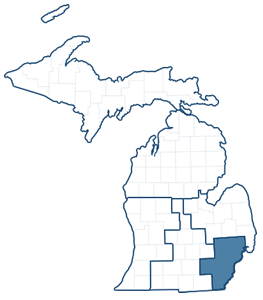Stabenow, Peters Introduce Legislation to Protect and Restore Recreational Fisheries
Friday, June 09, 2017As Free Fishing Weekend kicks off across Michigan, U.S. Senators Debbie Stabenow and Gary Peters introduced two bills to protect and restore fisheries across the state. Fishing is critical to tourism and our Michigan way of life. Millions of anglers visit the State of Michigan every year, contributing more than $4 billion to our economy. U.S. Senator Sherrod Brown (D-OH) also introduced both bills today.
“Our Great Lakes economy depends on tourism, including fishing and boating,” said Senator Stabenow. “We need to invest more to protect and restore our fisheries so that more people in Michigan and across the country can enjoy our amazing lakes and waterways and world-class opportunities for recreational and sport fishing.”
“Michigan’s fisheries are a lifeline to communities across the state that rely on the Great Lakes for economic opportunity and are a crucial component of what makes the Great Lakes so unique,” said Senator Peters. “I’m pleased to join Senator Stabenow in supporting our fisheries and making investments that will help the Great Lakes continue to thrive as an economic engine for Michigan’s tourism and boating industries.”
“The American Sportfishing Association salutes Senator Stabenow’s leadership in ensuring sound management and stewardship of the Great Lakes,” and Scott Gudes, Vice President for Government Affairs at the American Sportfishing Association. “Her bills to establish mass marking and aquatic connectivity, provide for protection of habitat, infrastructure and wise management of fisheries. This legislation will combat incursion of new invasive species and ensure that anglers have access to healthy game fish, both wild and hatchery stocks.”
"Opening up streams for Great Lakes fish is essential to improving species richness and the environment," said David Ullrich, chair of the Great Lakes Fishery Commission. "These bills, when enacted, will lead to healthier populations of desired fishes while still protecting streams from harmful invaders like sea lamprey. The Great Lakes Mass Marking Program would help fishery managers make essential decisions about the predator-prey balance in the lakes. The millions of people who enjoy the $7 billion fishery benefit from mass marking, and I urge Congress to pass this important legislation."
“The Great Lakes and recreational boating industry need improved infrastructure and access, and modernized systems and services in place that will strengthen public lands and waterways, contributing to lasting outdoor recreation experiences for visitors. We applaud the introduction of these bills, which lead the way in providing a proactive solution,” said Nicole Vasilaros, National Marine Manufacturers Association’s vice president of federal and legal affairs. “The recreational boating industry in the Great Lakes states has a total economic impact of $36.4 billion annually, supporting more than 7,100 businesses, most of which are small to medium-sized. Creating a 21st century infrastructure system in the Great Lakes is the first step in ensuring the region’s long term vitality and maximizing its potential economic impact on the local communities and U.S.”
The Great Lakes Aquatic Connectivity and Infrastructure Program Act (S. 1332) will improve Great Lakes fisheries and encourage habitat restoration by repairing and replacing aging dams, culverts, and roads. There are thousands of these structures across the Great Lakes Basin that currently inhibit the movement of fish populations. Great Lakes states and tribal governments will be able to recommend grant projects to the U.S. Fish and Wildlife Service to either expand fish access to waterways or prevent the spread of invasive species.
The Great Lakes Mass Marking Program Act (S. 1331) will make scientific technology available to track and monitor the health of fisheries in the Great Lakes. They will be used to make decisions to support and rehabilitate sport fish populations in the basin. This program was initiated in the Great Lakes on a limited scale in 2010, and will be fully established in statute under this legislation.
Next Article Previous Article
















